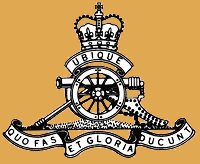
THE ROYAL AUSTRALIAN ARTILLERY
HISTORICAL SOCIETY
OF WESTERN AUSTRALIA (INC.)
THE LEIGHTON BATTERY
HERITAGE SITE
BUCKLAND HILL

| EARLY HISTORY
Buckland Hill, named by Captain Stirling after William Buckland, FRS, a reader in Geology at Oxford University and later Dean of Westminster, is the last remaining peak of seven hills in the area. It is one of the highest points in the Perth Metropolitan area. The area around Buckland Hill was extensively quarried in the early days of colonisation for building limestone. The Leighton Battery Heritage Site is in fact just west of the feature. It is thought that Willem de Vlaming, the early Dutch navigator landed close by this feature in 1697 and climbed the hill to ascertain what lay beyond it and in doing so noted the Swan River, which he named.
RECENT HISTORY
During the Great War, the Battery Observation Post also served as the Port War Signal Station, a naval facility used to signal vessels leaving and entering Gage Roads.
During the years immediately prior to World War II, industrial development in the port area masked some of the zones of fire covered by the forts. Consideration was given to relocating Fort Forrest to Buckland Hill. At that time the terminals for the overseas telegraphic cables ended just below on the beach at Leighton. There was concern that concussion from the gunfire would interfere with the delicate instruments located in the cable station and consequently the guns were emplaced at Swanbourne. An observation post still remained to assist Fort Arthur Head and the new Fort Swanbourne. In 1942, due to enemy activities, the cable station was closed for the duration of the war. Towards the end of 1942 authority had been given to relocate the Fort Arthur Head guns to Leighton where their prime task of "Examination Battery" could be fulfilled more satisfactorily. The guns were then emplaced on temporary mountings as it was already planned to equip the site with more modem weapons as soon as they became available from the United Kingdom. In the meantime over 300 metres of tunnels were excavated in places up to 10 metres below ground in which magazines for the storage of ammunition, communications, gun crew rest areas and observation posts were constructed. The Battery Commander was a mining engineer who used his knowledge to develop the complex.
The battery, which became known as the Leighton 6 inch Battery, was
commissioned in February 1943. Barracks for the personnel, two coast defence
searchlights and other associated facilities were built to serve the battery.
Prior to the 6-inch battery moving to Buckland Hill, a 3.7-inch anti aircraft
battery had been deployed near what is today the main entrance to the residential
estate.
The tenders for the construction of the A/A site were let in August of 1941 and the gun station was then commissioned about two weeks after the Japanese attack on Pearl Harbour. This provided Fremantle with the second gun station, the other being in Skinner Street, Fremantle where the John Curtin High School Sports Oval is now situated. In 1944 work commenced on the replacement battery for the Leighton 6-inch Battery. It comprised three 5.25-inch dual-purpose Coast Artillery/ AntiAircraft guns. This battery was known as 802 Battery and was sufficiently advanced by March 1945 for the 6-inch guns to be removed and transferred to the Princess Royal Battery at Albany.
In November 1945 the War Council deferred all defence construction to enable manpower and materials to be diverted to civil projects, which had been largely neglected during the war. It was not until 1948 that work recommenced at the site. By 1950, the Battery was sufficiently advanced for 1 Fixed Defence Brigade and a group from the School of Artillery to conduct a six-month training exercise utilising the guns. This was the only 5.25-inch battery out of the eight planned for Australian port defences to become operational. In 1951, 25 Medium Coast /AA Battery, Citizen Military Forces was formed to man the facility. It continued to operate in this capacity with several changes in title until 1963 at which time the Coast Artillery Branch of the Royal Regiment of Australian Artillery was disbanded.
Apart from the Battery Observation Post the original tunnel system was not used in association with the 5.25-inch Battery. A recommendation was put forward to extend the tunnel system to each of the 5.25-inch guns. Following an inspection it was decided that the electrical wiring throughout the existing tunnel system would need replacement and the tunnels were too damp for the storage of ammunition. The 5.25-inch guns and associated equipment were disposed of as scrap in 1963. The emplacements and tunnel entrances were blocked off and filled with rubble. The area associated with the battery, formed part of the University of WA endowment land grant. It was compulsorily acquired by the Commonwealth for defence purposes in the 1940's and was returned to the State Government in 1979. Amid some controversy, the land was sold for development as a housing estate, however one third of the area was surrendered as public open space. Following gazettal as an "A Class Reserve" the Society was granted permissive occupancy of the Battery area and authorised to develop the facility as a militaria museum. The site has been entered in the Register of the National Estate as a significant World War Two Coastal Defence Facility.
|












